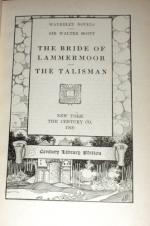more like nags. Detraction, which always pursues
merit with strides proportioned to its advancement,
has indeed alleged that Dick once upon a time painted
a horse with five legs, instead of four. I might
have rested his defence upon the license allowed to
that branch of his profession, which, as it permits
all sorts of singular and irregular combinations,
may be allowed to extend itself so far as to bestow
a limb supernumerary on a favourite subject.
But the cause of a deceased friend is sacred; and
I disdain to bottom it so superficially. I have
visited the sign in question, which yet swings exalted
in the village of Langdirdum; and I am ready to depone
upon the oath that what has been idly mistaken or
misrepresented as being the fifth leg of the horse,
is, in fact, the tail of that quadruped, and, considered
with reference to the posture in which he is delineated,
forms a circumstance introduced and managed with great
and successful, though daring, art. The nag being
represented in a rampant or rearing posture, the tail,
which is prolonged till it touches the ground, appears
to form a point d’appui, and gives the firmness
of a tripod to the figure, without which it would
be difficult to conceive, placed as the feet are, how
the courser could maintain his ground without tumbling
backwards. This bold conception has fortunately
fallen into the custody of one by whom it is duly valued;
for, when Dick, in his more advanced state of proficiency,
became dubious of the propriety of so daring a deviation
to execute a picture of the publican himself in exchange
for this juvenile production, the courteous offer
was declined by his judicious employer, who had observed,
it seems, that when his ale failed to do its duty in
conciliating his guests, one glance at his sign was
sure to put them in good humour.
It would be foreign to my present purpose to trace
the steps by which Dick Tinto improved his touch,
and corrected, by the rules of art, the luxuriance
of a fervid imagination. The scales fell from
his eyes on viewing the sketches of a contemporary,
the Scottish Teniers, as Wilkie has been deservedly
styled. He threw down the brush took up the crayons,
and, amid hunger and toil, and suspense and uncertainty,
pursued the path of his profession under better auspices
than those of his original master. Still the
first rude emanations of his genius, like the nursery
rhymes of Pope, could these be recovered, will be dear
to the companions of Dick Tinto’s youth.
There is a tankard and gridiron painted over the door
of an obscure change-house in the Back Wynd of Gandercleugh——But
I feel I must tear myself from the subject, or dwell
on it too long.




